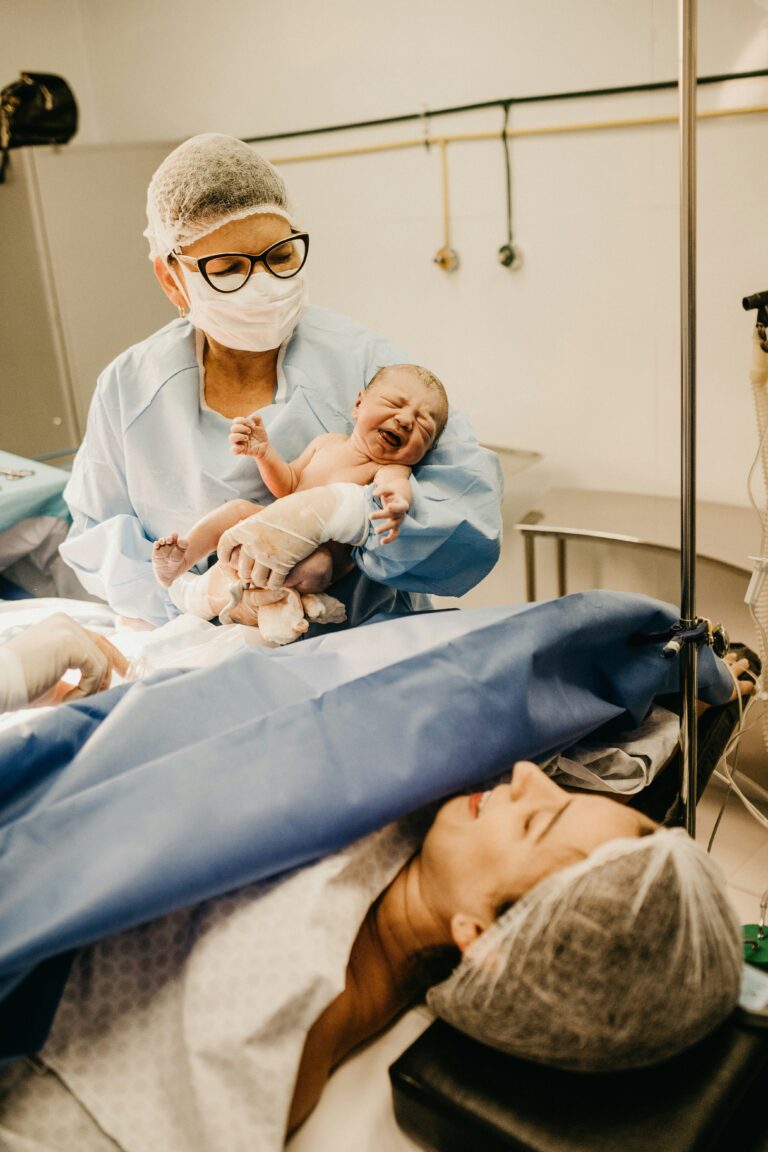If you’re reading this, likely, you’ve just had a cesarean birth (C-section) or you’re nervously anticipating the birth of your baby and want to be prepared in any situation. Maybe you are having a C-section by choice or your baby is breech, and with your medical team, you’ve decided to opt for a scheduled C-section. Any birth, whether vaginal or c-section is emotionally and physically challenging and the recovery process goes beyond just knowing the basics. It’s a major surgery that one in three women in the United States go through, and the journey towards healing can be very intense. Many women say it’s much more difficult than they anticipated.
You might know you’ll have a scar and you’ll be sore—but the physical aspect of c-section recovery is deeper than this. Your entire body may feel different, and simple things that you’ve never thought twice about—like getting up from a chair—can suddenly become an uphill battle.
Also, C-section recovery isn’t just physical: it’s deeply emotional. You might think the joy and relief of having your baby safely would overpower other emotions, and of course, it helps, but sometimes, feelings of sadness or even guilt can be just as intense. It’s okay to let yourself feel everything and take your time to recover. Your emotions are valid and part of the healing process.
C-section recovery, like many other things when it comes to growing, birthing and raising a baby, is so different from mother to mother. It’s so important that new and expecting moms know what C-section recovery looks like—so you can be as best prepared as you can be. Our guide is an honest, real and raw deep-dive into the physical and emotional aspects of C-section recovery, offering expert-backed support and encouragement. The more you know, the better you can feel empowered in your recovery journey.
What to Expect Immediately After a C-Section
When you have a C-section, it can feel like there’s a whirlwind of doctors, nurses and people swarming around you and your baby. It may also be the very first time in your life you’ve been in an operating room. It may be hard to process what’s happening, especially since you’re also at the end of your pregnancy, anticipating meeting your child—and having an abdominal surgery. If it sounds like a lot, you’re right—it is.
Right after the surgery, you may feel groggy from medications or feel nauseous. You’ll be brought to a recovery area where a nurse will take your vitals—like blood pressure and your heart rate—monitor your vaginal bleeding, because your body is still shedding the lining of your uterus, and check your uterus firmness, which helps in the complete expulsion of the placenta. As your anesthesia wears off, you might feel hit with what just happened, and the reality that you just brought your baby into the world starts to sink in.
In the first few days that follow, you may experience a few normal symptoms. You’ll be sore around your incision but don’t be surprised if you also feel sharp contractions, like period cramps. You’ll also probably have increased gas or bloating—because, yes, your intestines were probably moved around during the surgery and they’re making their way back. You might also experience brain fog, an itchy sensation around the incision, red vaginal discharge or bleeding and soreness in your lower stomach. Remember, all of this is completely normal and a part of the healing process.
Now, let’s talk about pain. And we won’t sugarcoat it for you: the first few hours and days after a C-section can be rough. But the good news is that your medical team is prepared. Your doctors will often have you take typical painkillers and if you’re having extreme pain, they may offer additional medication. Your nurses are also there to help you every step of the way— literally. They will help you get out of bed and to the bathroom, which might not seem like it, but even a few steps will feel like you ran a marathon. You might feel like you’re moving ridiculously slow, but your nurses want you to move without putting too much pressure or strain on your incision.
More than anything else, you’ll need ample support in the immediate aftermath of having a C-section. Your doctors, nurses, family and friends are all there to help you. Don’t be afraid to ask questions or be honest about how much pain you’re feeling. Remember, asking for help is a sign of strength—not weakness.

Physical Aspects of C-Section Recovery
Managing Pain and Discomfort
Managing your pain during c-section recovery can be one of the toughest parts. But knowing Your options and being prepared can make you feel more in control.
Your doctors will offer you typical painkillers after your surgery, like alternating between Tylenol and Motrin regularly. If you are in extreme discomfort, they may opt for a strong prescription medicine like oxytocin.
Your doctors know what can help you and what is safe for you and the baby if you’re breastfeeding. There are things you can do, too, to help your discomfort during C-section recovery. Staying on top of taking your medications, giving yourself permission to take it slow, and leaning on your support system are all things you can do to ease your discomfort. If your incision is extra uncomfortable, you can also try doing a scar massage.
“I like to do a scar massage on my patients and teach them how to do that on themselves,” Carrie Dominick, a physical therapist and certified strength and conditioning coach shared. “This helps the scar to not get too tight when it heals and pulls on the skin around it. Silicone strips that go over the scar are also helpful. They help the scar to heal and add a protective layer.”
Mobility and Movement
After you have your C-section, the idea of moving around may be the last thing you want to do. For example, you can’t go upstairs, carry your baby standing up, do any heavy lifting and essentially do anything that requires strain from your abdominal muscles. But moving is actually an essential part of C-section recovery. In fact, it’s recommended that you get out of bed and walk around within 24 hours after your surgery.
According to Shravya Kovela, pelvic and residency-trained, board-specialized orthopedic Doctor of Physical Therapy, in most cases, whenever you feel ready, you can begin diaphragmatic or ‘360’ breathing. To do this, Dr. Kovela says to begin in a supported position, such as lying on your back or side with your knees bent, and place your hands on your belly and ribs. Then, inhale gently through your nose as if you are smelling freshly baked cookies, and let your belly, ribs, and back rise within comfort. Lastly, exhale and let everything fall back to its original position. To progress this, she recommends moving to a seated position or to your hands and knees.
Movements like breathing can feel small, but they can help prevent lung congestion and relax your body and muscles. They can also promote circulation and reduce your belly pain.
Kovela recommends that after being cleared by your doctor, to start doing some gentle mobility exercises. You can rock your legs back and forth while lying on your back, do the cat cow stretch, kneeling hip flexor stretches or a figure four stretch in a seated position. However, she stresses to let your body guide how intense these movements are. If you’re feeling discomfort, only go to the point where you feel a gentle stretch. If you keep these movements in your routine, the more you do them, the further you’ll be able to stretch.
Incision Care and Healing
Caring for your c-section incision is so important for your healing journey. It’s a surgical wound and requires you to be diligent with the steps to care for it.
To care for your c-section incision, it’s important to follow a few simple steps.
- Gently clean and dry your incision everyday.
- Wear loose, soft and comfy clothing
- Wear cotton underwear
- If your incision is sore, stay on top of taking your medications
Like any other surgical wound, it’s susceptible to infections and complications. Keeping on top of the above steps will help reduce your risk for infection. But it’s also important to know what infection can look like.
While you care for your wound, make sure you watch out for these signs of infection.
- Increased swelling, pain or redness around you incision
- Fluid coming from the wound
- Abnormal vaginal bleeding
- Leg pain or swelling
- Increased stomach pain
- Fever-like symptoms like sweating, high temperature, chills, dehydration or fatigue
It’s important to note that these symptoms can take up to 30 days to develop. So even if you’re feeling better soon after, keep an eye on your incision and make sure you’re following the steps to care for it. If you do experience any of the signs of infection, reach out to your medical team for help.

Emotional and Psychological Impact
Coping with Emotional Challenges
While the physical aspect of c-section recovery is obvious and something you have to deal with, the emotional side is often overlooked. You might feel a mix of joy and relief after the process and finally getting to meet your baby. But it’s common to feel a wave of emotions.
Some women feel completely fine, but others might feel depressed or even experience symptoms of post-traumatic stress disorder. Some mothers feel the “baby blues,” which involve feelings of sadness or anxiety. It’s also normal to feel guilty, especially if your birth plan did not go as expected. On top of these emotions, you’re also adjusting to being a new mother to a newborn who needs you 24/7, with little rest, recovery or sleep. It can feel incredibly overwhelming, and that’s not only normal, but expected during the fourth trimester.
If you’re feeling disappointed or anxious, there are a few things you can do that may help. You may feel cheated in a sense like you missed out on the birth experience that you saw for yourself. The first thing you should do is acknowledge your feelings. Don’t wish that your feelings would go away or pass. Instead, allow yourself to feel and sit with them. Next, you should communicate your feelings to your medical team, family or friends. They can offer you support, even if it’s just a listening ear.
Importance of Mental Health Support
Caring for your mental health is so essential in your c-section recovery journey. Looking into therapy or support groups can be game changers.
“For many moms who were not expecting to have a C-section, therapy and support groups can help them process the trauma of not having the birth they wanted and also to know they are not alone,” Dominick shared. “It is really helpful to talk to other moms going through the same process to know what is normal and to know you are not alone in this process.”
When communicating with your family and healthcare providers, be honest about what you’re feeling. If you’re struggling emotionally, telling your support system is okay. Be specific about what can help you, even if it’s “Hey, can you watch the baby for an hour while I take a nap and shower?” Don’t minimize what you’re feeling to your healthcare providers. You might need to downplay your feelings because the focus should be on your baby. But you are just as important.
Lifestyle Adjustments During Recovery
As you adjust to your life with your baby, your C-section recovery will require some lifestyle changes to avoid infection and encourage the healing process.. We know all you want to do is care for your little one—but you have to balance taking care of yourself too.
Nutrition and Hydration
Nutrition and hydration are two essential parts of recovery. They provide your body with all the essential nutrients it needs to heal properly and give you energy. They help your tissue repair, boost your immune system to fight off any potentially harmful infections, support healthy circulation to the wound and flush out toxins.
Eat plenty of fruits and vegetables in your meals and drink plenty of fluids, especially water. You should be drinking between 1.5 to two liters of water everyday. If you are breastfeeding, add another liter of water to your to do list. If plain water isn’t appealing, you can always try drinking herbal teas or infusing your water with some lemon or fruit to flavor it.
Rest and Sleep
While ideally, you would have seven hours of sleep each night to recover from your C-section, we know that getting consistent sleep with a newborn isn’t exactly a realistic goal. That said, if your partner has leave and can handle the middle-of-the-night feeds for the first few weeks, it’ll tremendously improve your healing process. Or, if you have family or friends to lean on, now is the time to ask for help. Overnight doulas may be an option for those with a budget to support the expense. . When you are able to get some shut-eye, try to make your bedroom extra comfy for sleep. Get blackout curtains, an air purifier and eliminate extra noises so that when you do finally rest your eyes, you’re getting quality sleep. Remember, even if it’s a quick nap, it can help aid your recovery.
Managing Household Responsibilities
Managing all the household chores, your baby’s needs, breastfeeding (and/or pumping) and trying to recover is a lot for anyone—especially someone who just had a significant surgery. There’s no other major surgery where a person is asked to take care of someone else (a.k.a: a baby) immediately after the procedure. So, in case you need the reminder, it’s beyond okay to ask for help.
Whether creating a plan with your partner to take shifts during the night so you can sleep or making a list of tasks that your support system can help out with, it can alleviate some of the stress placed on you. When your friends and family offer help, say yes! They can bring meals, run errands for you or even just sit with the baby for an hour.
As you navigate your C-section recovery, one of the best things you can do for yourself is to set realistic goals and expectations. We know you might feel guilty for not being able to be there for your baby in the ways you wanted to be. But you will get there with time. Focus on small milestones. Were you able to stand the entire time in the shower? Let’s go! We’re proud of you.
C-section recovery is an incredibly challenging experience. But with the tips we’ve offered advice from your medical team and support from your family and friends, you can work through it confidently. Your village is there to help you, so don’t be afraid to lean on them. Don’t hesitate to ask your medical team for help, either. If you’re experiencing pain or abnormal discomfort, reach out. They want to help you.
This healing process takes time—and it’s not a straight line. One day, you might feel like you can get up and do everything you can, but the next, you might be bedridden, unable to move without pain. Give yourself patience. Treat yourself like you would treat your tiny new best friend: with love, kindness and empathy.
Author
-

Esha Minhas is a third-year student at Northeastern University studying Journalism and Political Science. She's currently the editorial and social intern for Mila & Jo Media. Esha is also the Deputy Sports Editor for The Huntington News and covers Northeastern men's hockey. When she's not busy with work or school, you can find her at the gym, baking for her friends and family and watching anything sports related.
View all posts




